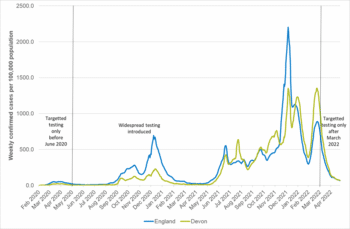Contents
1. Introduction
This is my second Annual Public Health Report for Devon County Council. My report last year, not unsurprisingly, focused on COVID-19, highlighting the impact the pandemic had on individuals, families and communities within Devon and how agencies and community groups came together to respond to the pandemic and support one another. While we all may have hoped that COVID-19 would not have needed to be included within this year’s annual report this unfortunately is not the case. My report this year does continue with the story of the Pandemic and examines the wider impact and what ‘living with covid’ looks like.
The evidence is clear, and I included a chapter in my report last year, that the COVID-19 pandemic has impacted disproportionality on certain groups amongst the population and many people in these groups were suffering poor health before the pandemic, so the pandemic has made the health of these individuals worse.
My report also examines the current ‘cost-of-living crisis’, being driven by rising energy, fuel and food prices, and inflation currently at its highest rate for 30 years. The ‘cost-of-living crisis’, is clearly having an impact on all Devon residents but as with the pandemic we know the impact with be felt most by those in greatest need. The report highlights the potential impact on people’s health and wellbeing and crucially health inequalities. We have seen throughout the pandemic individuals and the voluntary and community sector come together to provide magnificent support and help to individuals and families it is vital that we continue to focus local support on those most disadvantaged to help reduce the inevitable impact of this crisis.
I would once again, personally like to thank the people of Devon for how they have conducted themselves during the pandemic, adhering to the general public health guidance, testing guidance and isolation rules which has helped to keep infection rates as low as possible and help keep people safe.
I also wish again to offer my thanks to local service providers, partners, organisations and the community and voluntary sector who have continued their tremendous work, working together to respond to the needs of Devon residents during the pandemic.
It is important that people understand that COVID-19 is not over and achieving elimination is unviable, at least in the short-term. We all need to learn to live safely with covid for the foreseeable future. We are likely to see new variants which may well be more transmissible, and our current vaccines may offer less protection than against previous variants, so it is important that we all take responsibility to manage the covid risk to ourselves, our loved ones and to others in our communities. Our aim is to enable people to do this, and support those who cannot, so we can all live safely with Covid.
Steven Brown, Director of Public Health
2. COVID-19 Update
The COVID 19 pandemic continued through 2021/22. It is evident that restrictions such as the second and third lockdown in December 2020 and January 2021 and the rollout of phase 1 of the vaccination programme had an impact on case rates, hospitalisations and deaths during Spring 2021. Overall case rates, people admitted to hospital with COVID-19 and deaths during this period remained low and relatively unchanged.
Following the lifting of restrictions throughout Spring, by June 2021 there was a clear step change with case rates climbing to some of the highest rates for Devon over the course of the pandemic. There are many factors which may have influenced these increases. Restrictions over the course of this time were lifting and by the 19th of July, most legal limits on social contact were removed in England, and the remaining closed sectors of the economy were allowed to reopen. This coincided with the detection of the highly transmissible Delta variant which later became the dominant strain globally. Testing rates in Devon continued to be above the national average during this period and the number of people testing positive remained high following a pattern of multiple waves. Often increases in COVID-19 rates across younger age groups were a marker for anticipated increases across the general population. This was a typical pattern observed throughout the course of pandemic where increases in working age and older age population would follow the increases in cases in younger age groups. Despite higher case rates, hospitalisations and deaths remained lower during this time which was a clear indication of the efficacy and high uptake rates of the COVID-19 vaccine across Devon.
By the Autumn 2021, a new variant (Omicron) was detected. This particular variant spread more quickly than earlier variants. As such starker increases were observed both locally and nationally between Autumn 2021 and March 2022. This coincided with the cessation of the legal requirement to self-isolate at the end of February which would have also contributed to the higher COVID-19 rates during that time. In addition, given the staggered approach to the vaccine, waning of the vaccine started to become apparent and as well as higher case rates being observed, reinfection rates also increased. By March 2022, hospitalisations reached the highest peak observed throughout the pandemic in Devon and while deaths did increase over this period, this conversion rate was lower compared to the pre-vaccination phase of the pandemic.
Figure 1.1: Trend of COVID-19 case rates per 100,000 population across Devon
